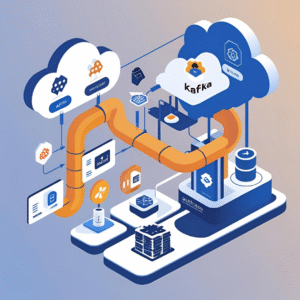Mastering Data Analytics interview questions: Top 30 Questions Answered with Real-World Insights

Introduction–Data Analytics interview questions
In today’s data-driven world, data analytics has become a core component of decision-making across industries. From top-tier tech companies like Google and Amazon to financial institutions and startups, the role of a Data Analyst is increasingly critical. However, cracking a data analyst interview, especially with MAANG (Meta, Amazon, Apple, Netflix, Google) companies, demands more than just basic knowledge. It requires a deep understanding of data handling, statistical inference, database management, visualization techniques, and business acumen.
This blog compiles and elaborates on 30 of the most frequently asked Data Analytics interview questions. Whether you’re preparing for your first role or aiming for a career switch, this guide will help you build confidence and tackle interviews with clarity.

1. What is the difference between OLTP and OLAP?
OLTP (Online Transaction Processing) and OLAP (Online Analytical Processing) serve different purposes:
- OLTP is designed for managing transaction-oriented applications. It handles day-to-day data entry and retrieval operations, typically characterized by a large number of short online transactions.
- OLAP, on the other hand, is used for analytical purposes. It supports complex queries and is optimized for data analysis and decision-making. OLAP systems process large volumes of data and allow multidimensional analysis.
Example:
- OLTP: Banking systems for transactions
- OLAP: Business Intelligence dashboards for sales analysis
2. How would you clean a dataset with 10% missing values?
Cleaning data with missing values is essential to ensure the accuracy of analysis. The steps include:
- Assess Missing Data: Use tools like Pandas (Python) or SQL COUNT to identify columns with missing values.
- Decide Handling Methods:
- For numerical data: Impute using mean, median, or predictive modeling.
- For categorical data: Use mode or create an ‘Unknown’ category.
- Evaluate Bias: Ensure your imputation method does not introduce bias.
- Documentation: Record what methods were used for reproducibility.
3. How do you design an ETL pipeline for real-time analytics?
ETL (Extract, Transform, Load) pipelines for real-time analytics require stream processing:
- Extract: Use Kafka or APIs to ingest real-time data.
- Transform: Apply on-the-fly operations using Apache Flink or Spark Streaming.
- Load: Store processed data in warehouses like Google BigQuery or Amazon Redshift.
A well-designed ETL pipeline ensures low latency, fault tolerance, and scalability.

4. How do you ensure data quality in a project?
Data quality can make or break a project. Key steps include:
- Clear Data Standards: Define guidelines for data collection and entry.
- Validation Rules: Use tools or scripts to ensure data type, format, and range correctness.
- Cleaning: Remove duplicates, correct anomalies.
- Timely Updates: Ensure data freshness.
- Audits: Periodically verify data integrity and accuracy.
5. What is the importance of p-values in hypothesis testing?
A p-value helps determine the statistical significance of your results:
- If p < 0.05, reject the null hypothesis, suggesting the results are statistically significant.
- If p ≥ 0.05, fail to reject the null hypothesis, indicating insufficient evidence.
It aids in making data-driven decisions and understanding whether results are due to chance.
6. What is the difference between normalization and standardization?–Data Analytics interview questions
- Normalization: Rescales data to a range of [0,1]. Useful when data needs to be compared proportionally.
- Standardization: Centers data around the mean with a standard deviation of 1. Preferred when data follows a Gaussian distribution.
Choosing between the two depends on the algorithm (e.g., k-means prefers normalized data).
7. How would you optimize a SQL query for large datasets?
Tips for SQL optimization:
- Use Indexes: Speeds up SELECT and JOIN operations.
- Limit Columns: Avoid SELECT *.
- Efficient Joins: Use INNER JOINs when possible.
- Early Filtering: Use WHERE before joins to reduce data size.
- Analyze Execution Plans: Use EXPLAIN in SQL to detect bottlenecks.
8. How do you handle skewed data distributions?
Skewed data can affect model accuracy. Techniques include:
- Log Transformation: Normalize data distribution.
- Winsorization: Cap extreme values.
- Resampling: Balance classes (e.g., SMOTE for oversampling).
- Model Selection: Use tree-based models that are robust to skew.
9. What is a Type I and Type II error?
- Type I Error (False Positive): Rejecting a true null hypothesis.
- Example: A medical test indicates a disease when it’s not present.
- Type II Error (False Negative): Failing to reject a false null hypothesis.
- Example: A test fails to detect a disease that is present.
10. Difference between LEFT JOIN and FULL OUTER JOIN in SQL?
- LEFT JOIN: Returns all records from the left table and matched records from the right table. Unmatched right-side records show as NULL.
- FULL OUTER JOIN: Returns all records from both tables. Non-matching rows from both sides contain NULLs.

11. How would you design a dashboard to track product performance?
Elements of a product performance dashboard:
- KPIs: Sales, Revenue, Customer Retention
- Charts: Line for trends, Bar for comparisons
- Filters: Date range, Region, Product category
- Alerts: Notify stakeholders of anomalies
- Real-time Refresh: Auto-updates with data pipeline
12. When do you choose RDBMS vs NoSQL?
- RDBMS: Use for structured data and transactional consistency. (e.g., PostgreSQL, MySQL)
- NoSQL: Use for semi/unstructured data, horizontal scaling. (e.g., MongoDB, Cassandra)
13. What is data normalization in databases?
Data normalization reduces data redundancy:
- Breaks large tables into smaller ones.
- Defines relationships using foreign keys.
- Ensures consistency and avoids anomalies.
14. How do you detect and handle outliers in a dataset?
- Detect:
- Visual: Box plots, scatter plots
- Statistical: IQR, Z-score
- Handle:
- Remove if it’s a data entry error
- Cap or transform using log/sqrt
- Impute with median or max threshold
15. What is A/B testing and how do you approach it?
A/B testing compares two versions:
- Define hypothesis (e.g., new feature increases conversion)
- Randomly assign users to control (A) and variant (B)
- Collect and analyze data using t-tests or z-tests
- Determine statistical significance
16. Difference between batch processing and stream processing?
- Batch Processing: Analyzes data in chunks (daily reports)
- Stream Processing: Real-time analysis (live user activity tracking)
Use cases determine the choice.
17. How to optimize joins in SQL queries?
- Use indexed columns
- Apply filters before joining
- Prefer INNER JOIN over OUTER when possible
- Join only required tables
- Analyze the query plan
18. How to design a data warehouse using star schema?
Steps:
- Identify business process
- Define fact table (metrics)
- Define dimension tables (time, product, etc.)
- Link with foreign keys
- Optimize queries using denormalized structure
19. How to calculate 90th percentile of sales in SQL?
Use:
SELECT PERCENTILE_CONT(0.9) WITHIN GROUP (ORDER BY sales) AS percentile_90
FROM sales_table;
20. Difference between star schema and snowflake schema?
- Star Schema: Dimension tables are denormalized.
- Snowflake Schema: Dimension tables are normalized into multiple related tables.
Star is simpler and faster for queries; snowflake reduces data redundancy.
Data Analytics interview questions—2nd level
21. What is indexing in databases?
Indexing improves query performance by:
- Creating lookup structures (B-tree, Hash index)
- Reducing the need to scan the entire table
22. How to calculate churn rate in SQL?
Steps:
- Count users who joined before start date.
- Count users who churned between start and end date.
- Use:
SELECT (CAST(churned_customers AS FLOAT)/total_customers_start)*100 AS churn_rate
23. When to use Python vs SQL in data tasks?
- SQL: For structured data querying, joins, aggregation
- Python: For data cleaning, modeling, machine learning
24. Supervised vs Unsupervised Learning
- Supervised: Labeled data; predict outcomes (e.g., regression, classification)
- Unsupervised: Unlabeled data; find patterns (e.g., clustering, association)
25. How to prioritize tasks in a data analytics project?
- Define business objective
- Assess impact
- Map dependencies
- Allocate resources
- Set timelines
- Review and iterate
26. Choosing right visualizations for data
- Comparison: Bar chart
- Distribution: Histogram
- Trends: Line chart
- Composition: Pie chart
- Relationships: Scatter plot
27. Difference between UNION and UNION ALL?
- UNION: Removes duplicates
- UNION ALL: Keeps duplicates; faster
Use UNION for unique results, UNION ALL for performance.
28. Ensuring scalability in data pipelines
- Use distributed tools (Spark, Kafka)
- Horizontal scaling
- Modular architecture
- Auto-scaling
- Monitoring and alerting
29. Handling correlated variables in predictive modeling
- Identify correlation using matrix
- Remove or combine redundant features
- Use regularization (Lasso, Ridge)
- Apply PCA
- Use domain knowledge
30. Difference between RANK() and DENSE_RANK() in SQL
- RANK(): Leaves gaps in ranking
- DENSE_RANK(): No gaps in ranking
Example:
- RANK(): 1, 1, 3
- DENSE_RANK(): 1, 1, 2

Conclusion–Data Analytics interview questions
Preparing for a Data Analytics interview requires a strategic approach. These 30 questions cover foundational to advanced concepts and are designed to help you demonstrate both technical proficiency and practical understanding. Continue practicing with real-world datasets, refining your SQL and Python skills, and aligning your problem-solving approach with business goals.
Good luck with your next interview!
📚 Learning Platforms & Certification Resources–Data Analytics interview questions
-
Google Data Analytics Professional Certificate (Coursera)
Link: https://www.coursera.org/professional-certificates/google-data-analytics
Anchor Suggestion: Google’s Data Analytics Certificate on Coursera -
IBM Data Analyst Professional Certificate
Link: https://www.coursera.org/professional-certificates/ibm-data-analyst
Anchor Suggestion: IBM Data Analyst Program -
Mode Analytics SQL Tutorial
Link: https://mode.com/sql-tutorial/
Anchor Suggestion: SQL tutorial for analysts by Mode Analytics
📖 Documentation and References
-
Pandas Documentation (Python Library for Data Handling)
Link: https://pandas.pydata.org/docs/
Anchor Suggestion: Pandas official documentation -
Apache Kafka Documentation
Link: https://kafka.apache.org/documentation/
Anchor Suggestion: Kafka streaming documentation -
Apache Spark Streaming Guide
Link: https://spark.apache.org/docs/latest/streaming-programming-guide.html
Anchor Suggestion: Spark Streaming programming guide
📊 Dashboards and Visualization Tools–Data Analytics interview questions
-
Tableau Public Gallery
Link: https://public.tableau.com/app/discover
Anchor Suggestion: Interactive dashboards on Tableau Public -
Power BI Learning Resources (Microsoft)
Link: https://learn.microsoft.com/en-us/power-bi/
Anchor Suggestion: Power BI learning center
🔍 Stats & Data Science Concepts
-
Khan Academy – Hypothesis Testing
Link: https://www.khanacademy.org/math/statistics-probability/significance-tests-confidence-intervals
Anchor Suggestion: Khan Academy on hypothesis testing -
Scikit-learn – Supervised & Unsupervised Learning Overview
Link: https://scikit-learn.org/stable/supervised_learning.html
Anchor Suggestion: Scikit-learn’s machine learning guide
🌐 Authoritative Tech Blogs
-
Towards Data Science (Medium Blog)
Link: https://towardsdatascience.com/
Anchor Suggestion: Read expert articles on Towards Data Science -
Google Cloud Blog – Data Engineering & Analytics
Link: https://cloud.google.com/blog/products/data-analytics
Anchor Suggestion: Google Cloud’s analytics insights
Data Analytics interview questions–Completed
For Aptitude Questions: Click Here
